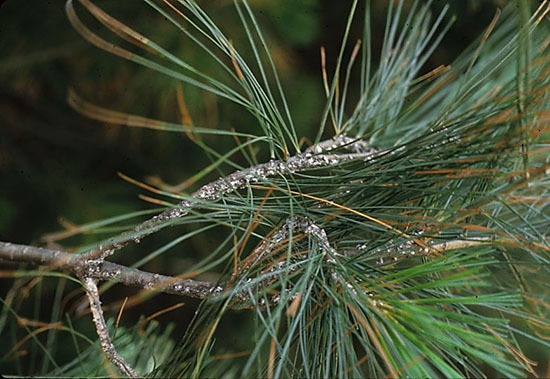Introduction
White pine bark adelgid (Pineus strobi) is a small insect that defoliates eastern white pine, and several other species of pine. Though seldom fatal, severe infestations can be an aesthetic nuisance. Persistent defoliation can reduce plant vigor, and render the host more susceptible to invasion from tree pathogens, and other pests.
Distribution & Habitat
White pine bark adelgid occurs throughout North America and Europe. It appears principally throughout the native range of eastern white pine.
Hosts
White pine bark adelgid is primarily attracted to white pine. The insect also infests jack, ponderosa, pitch, and scotch pines.
Description
White pine bark adelgid is a small black insect. It resembles an aphid, but has shorter antennae. The insect also lacks cornicles on its abdomen. White pine bark adelgid resides within a wooly mass that it secretes for protection. When populations are dense, the wooly masses coalesce, forming one large communal web.
Life Cycle
White pine bark adelgid produces up to five generations per season. Generations may overlap, with adults, nymphs, and crawlers all present on the same communal web. Immature females overwinter in the bark of pines. Once spring temperatures exceed 50°F, the nymphal females become active. By late April, they enshroud themselves in a white, wooly material. Within this wooly material, the females mature and molt into wingless adults. In early April, the females lay forty to fifty eggs on the branches and trunk of host trees. The eggs hatch two weeks later, revealing masses of larvae. The larvae navigate to suitable feeding locations, where they use their long, needle-like mouthparts to pierce the tree bark, and consume the sap. Feeding is limited to the bark of the tree. The larvae eventually develop wings, or remain wingless. The winged larvae vacate the tree, and migrate to new hosts, where they lay eggs. The wingless larvae remain on the host to mature and reproduce. As they develop, the wingless larvae often conceal themselves beneath the husks of dead adults, at the base of old needles, and under newly emerging needles. Here, they envelop themselves in waxy coverings and continue to feed, maturing within twenty to thirty days. Upon reaching maturity, the adults mate. Adult males and young nymphs expire during the winter. Nymphs that have progressed to at least their third instar overwinter.
Effects on Pines
Infestations are most recognizable by the presence of the white, cottony material produced by the insect on the bark of trunks and limbs, as well as at the base of needles or buds. Severely infested trees may be covered in wooly masses. These cottony masses are an aesthetic nuisance, and can reduce the ornamental value of host trees. Severe infestations on the branches of pines can result in extensive foliar dieback. Foliage may become blackened from the material produced by the nymphs and adults. If not tended to, persistent infestation can culminate in tree mortality.
Management
- Maintain tree vigor through sound cultural practices. Ensure trees are sufficiently watered, especially during extended periods of drought. Apply a layer of organic mulch around the base of susceptible trees to improve soil quality, moderate soil temperature, and retain soil moisture.
- White pine bark adelgid has several natural predators that help to limit its populations. These include lady beetles, lacewings, and hover flies.
- Dormant oil sprays can be used to eradicate the overwintering nymphs. Applications are most effective when performed in spring or fall. Thorough coverage of the trunk and branches is required.
- Registered insecticides can be applied in mid-April to kill the overwintering nymphs before they mature, and lay their eggs. Summer applications are effective. Two to three sprays at weekly intervals are necessary to effectively control the larvae.
Photo courtesy of Phil Nixon/University of Illinois


